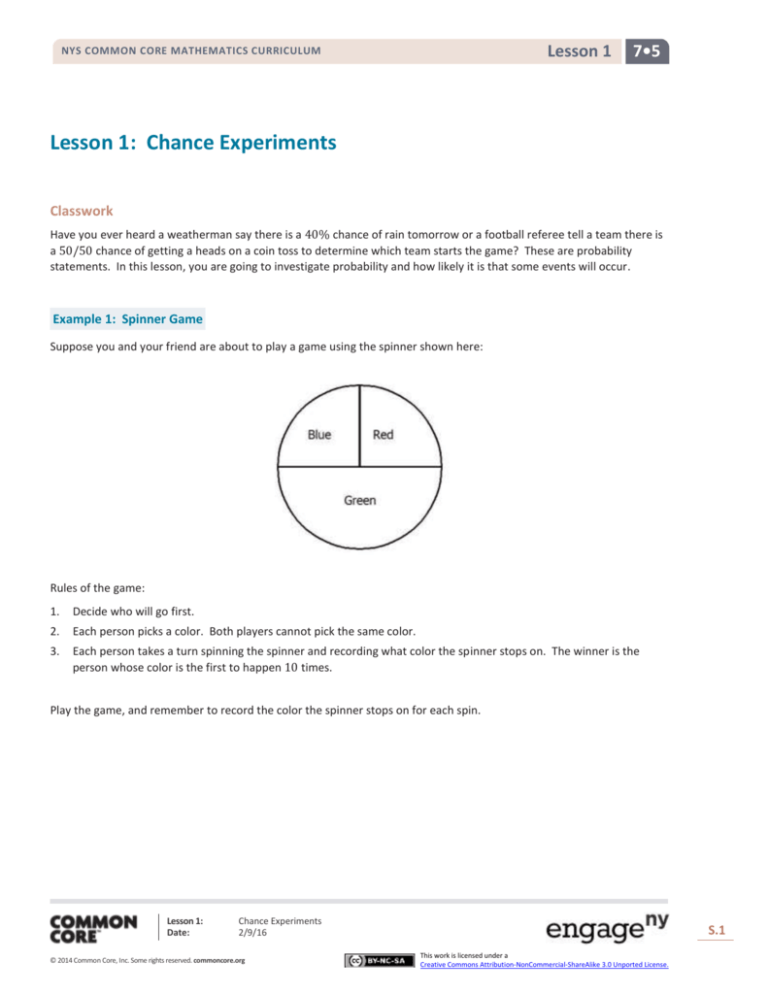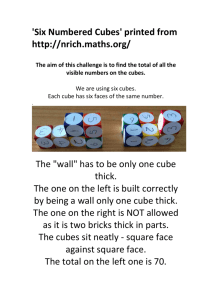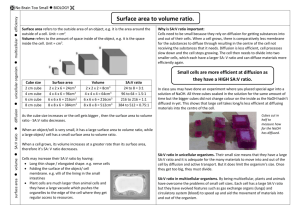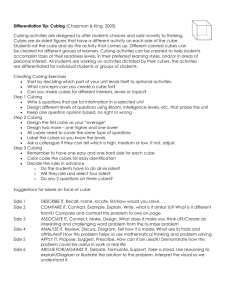
Lesson 1
NYS COMMON CORE MATHEMATICS CURRICULUM
7•5
Lesson 1: Chance Experiments
Classwork
Have you ever heard a weatherman say there is a 40% chance of rain tomorrow or a football referee tell a team there is
a 50/50 chance of getting a heads on a coin toss to determine which team starts the game? These are probability
statements. In this lesson, you are going to investigate probability and how likely it is that some events will occur.
Example 1: Spinner Game
Suppose you and your friend are about to play a game using the spinner shown here:
Rules of the game:
1.
Decide who will go first.
2.
Each person picks a color. Both players cannot pick the same color.
3.
Each person takes a turn spinning the spinner and recording what color the spinner stops on. The winner is the
person whose color is the first to happen 10 times.
Play the game, and remember to record the color the spinner stops on for each spin.
Lesson 1:
Date:
Chance Experiments
2/9/16
© 2014 Common Core, Inc. Some rights reserved. commoncore.org
S.1
This work is licensed under a
Creative Commons Attribution-NonCommercial-ShareAlike 3.0 Unported License.
Lesson 1
NYS COMMON CORE MATHEMATICS CURRICULUM
7•5
Exercises 1–4
1.
Which color was the first to occur 10 times?
2.
Do you think it makes a difference who goes first to pick a color?
3.
Which color would you pick to give you the best chance of winning the game? Why would you pick that color?
4.
Below are three different spinners. On which spinner is the green likely to win, unlikely to win, and equally likely to
win?
Spinner A
Spinner B
Spinner C
Green
Red
Green
Red
Green
Lesson 1:
Date:
Red
Chance Experiments
2/9/16
© 2014 Common Core, Inc. Some rights reserved. commoncore.org
S.2
This work is licensed under a
Creative Commons Attribution-NonCommercial-ShareAlike 3.0 Unported License.
Lesson 1
NYS COMMON CORE MATHEMATICS CURRICULUM
7•5
Example 2: What is Probability?
Probability is a measure of how likely it is that an event will happen. A probability is indicated by a number between 0
and 1. Some events are certain to happen, while others are impossible. In most cases, the probability of an event
happening is somewhere between certain and impossible.
For example, consider a box that contains only red cubes. If you were to select one cube from the bag, you are certain
to pick a red one. We say that an event that is certain to happen has a probability of 1. If we were to reach into the
same bag of cubes, it is impossible to select a yellow cube. An impossible event has a probability of 0.
Description
Example
Explanation
Some events are impossible. These
events have a probability of 0.
You have a bag with two green
cubes, and you select one at
random. Selecting a blue cube is
an impossible event.
There is no way to select a blue
cube if there are no blue cubes in
the bag.
Some events are certain. These
events have a probability of 1.
You have a bag with two green
cubes, and you select one at
random. Selecting a green cube is
a certain event.
You will always get a green cube if
there are only green cubes in the
bag.
You have a bag with one blue cube
and one red cube, and you
randomly pick one. Selecting a
blue cube is equally likely to
happen or not to happen.
Since exactly half of the bag is
made up of blue cubes and
exactly half of the bag is
comprised of red cubes, there is a
50/50 chance (equally likely) of
selecting a blue cube and a 50/50
chance (equally likely) of NOT
selecting a blue cube.
Some events are more likely to
happen than not to happen. These
events have a probability that is
greater than 0.5. These events
could be described as likely to occur.
If you have a bag that contains
eight blue cubes and two red
cubes, and you select one at
random, it is likely that you will get
a blue cube.
Even though it is not certain that
you will get a blue cube, a blue
cube would be selected most of
the time because there are many
more blue cubes than red cubes.
Some events are less likely to
happen than not to happen. These
events have a probability that is less
than 0.5. These events could be
described as unlikely to occur.
If you have a bag that contains
eight blue cubes and two red
cubes, and you select one at
random, it is unlikely that you will
get a red cube.
Even though it is not impossible to
get a red cube, a red cube would
not be selected very often
because there are many more
blue cubes than red cubes.
Some events are classified as equally
likely to happen or to not happen.
1
These events have a probability of .
2
Lesson 1:
Date:
Chance Experiments
2/9/16
© 2014 Common Core, Inc. Some rights reserved. commoncore.org
S.3
This work is licensed under a
Creative Commons Attribution-NonCommercial-ShareAlike 3.0 Unported License.
Lesson 1
NYS COMMON CORE MATHEMATICS CURRICULUM
The figure below shows the probability scale.
7•5
Probability Scale
Probability Scale
C
A
E
B
1/2
0
Unlikely
Impossible
0
Impossible
Unlikely
D
1
Equally Likely to
Occur or1/2
Not Occur
Likely
Equally Likely to
Occur or Not Occur
Likely
Certain
1
Certain
Exercises 5–10
5.
Decide where each event would be located on the scale above. Place the letter for each event on the appropriate
place on the probability scale.
Event:
A. You will see a live dinosaur on the way home from school today.
B.
A solid rock dropped in the water will sink.
C.
A round disk with one side red and the other side yellow will land yellow side up when flipped.
D. A spinner with four equal parts numbered 1–4 will land on the 4 on the next spin.
E.
Your full name will be drawn when a full name is selected randomly from a bag containing the full names of
all of the students in your class.
F.
A red cube will be drawn when a cube is selected from a bag that has five blue cubes and five red cubes.
G. Tomorrow the temperature outside will be −250 degrees.
6.
Design a spinner so that the probability of spinning green is 1.
Lesson 1:
Date:
Chance Experiments
2/9/16
© 2014 Common Core, Inc. Some rights reserved. commoncore.org
S.4
This work is licensed under a
Creative Commons Attribution-NonCommercial-ShareAlike 3.0 Unported License.
Lesson 1
NYS COMMON CORE MATHEMATICS CURRICULUM
7.
Design a spinner so that the probability of spinning green is 0.
8.
Design a spinner with two outcomes in which it is equally likely to land on the red and green parts.
7•5
An event that is impossible has a probability of 0 and will never occur, no matter how many observations you make. This
means that in a long sequence of observations, it will occur 0% of the time. An event that is certain has a probability of
1 and will always occur. This means that in a long sequence of observations, it will occur 100% of the time.
9.
1
What do you think it means for an event to have a probability of ?
2
1
10. What do you think it means for an event to have a probability of ?
4
Lesson 1:
Date:
Chance Experiments
2/9/16
© 2014 Common Core, Inc. Some rights reserved. commoncore.org
S.5
This work is licensed under a
Creative Commons Attribution-NonCommercial-ShareAlike 3.0 Unported License.
Lesson 1
NYS COMMON CORE MATHEMATICS CURRICULUM
7•5
Lesson Summary
Probability is a measure of how likely it is that an event will happen.
A probability is a number between 0 and 1.
The probability scale is as follows:
Probability Scale
Probability Scale
C
A
E
B
1/2
0
Unlikely
Impossible
0
Impossible
Unlikely
Equally Likely to
Occur or1/2
Not Occur
Equally Likely to
Occur or Not Occur
D
Likely
1
Certain
1
Likely
Certain
Problem Set
1.
Match each spinner below with the words impossible, unlikely, equally likely to occur or not occur, likely, and certain
to describe the chance of the spinner landing on black.
Spinner A
Spinner B
Spinner D
Spinner E
Lesson 1:
Date:
Spinner C
Chance Experiments
2/9/16
© 2014 Common Core, Inc. Some rights reserved. commoncore.org
S.6
This work is licensed under a
Creative Commons Attribution-NonCommercial-ShareAlike 3.0 Unported License.
Lesson 1
NYS COMMON CORE MATHEMATICS CURRICULUM
2.
3.
7•5
Decide if each of the following events is impossible, unlikely, equally likely to occur or not occur, likely, or certain to
occur.
a.
A vowel will be picked when a letter is randomly selected from the word lieu.
b.
A vowel will be picked when a letter is randomly selected from the word math.
c.
A blue cube will be drawn from a bag containing only five blue and five black cubes.
d.
A red cube will be drawn from a bag of 100 red cubes.
e.
A red cube will be drawn from a bag of 10 red and 90 blue cubes.
A shape will be randomly drawn from the box shown below. Decide where each event would be located on the
probability scale. Then, place the letter for each event on the appropriate place on the probability scale.
Event:
A. A circle is drawn.
B.
A square is drawn.
C.
A star is drawn.
D. A shape that is not a square is drawn.
Lesson 1:
Date:
Chance Experiments
2/9/16
© 2014 Common Core, Inc. Some rights reserved. commoncore.org
S.7
This work is licensed under a
Creative Commons Attribution-NonCommercial-ShareAlike 3.0 Unported License.
Lesson 1
NYS COMMON CORE MATHEMATICS CURRICULUM
4.
Color the cubes below so that it would be equally likely to choose a blue or yellow cube.
5.
Color the cubes below so that it would be likely but not certain to choose a blue cube from the bag.
6.
Color the cubes below so that it would be unlikely but not impossible to choose a blue cube from the bag.
7.
Color the cubes below so that it would be impossible to choose a blue cube from the bag.
Lesson 1:
Date:
7•5
Chance Experiments
2/9/16
© 2014 Common Core, Inc. Some rights reserved. commoncore.org
S.8
This work is licensed under a
Creative Commons Attribution-NonCommercial-ShareAlike 3.0 Unported License.









